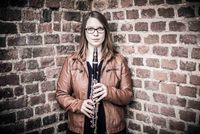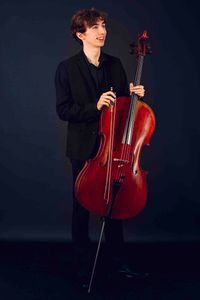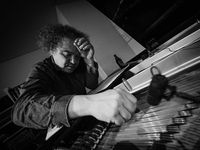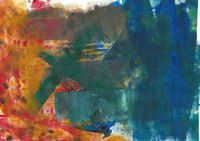Zikkus
CD with works by the composer Daniel Osorio (2021)
*Gefördert durch die Initiative Musik gemeinnützige Projektgesellschaft mbH im Rahmen von Neustart Kultur mit Projektmitteln der Beauftragten der Bundesregierung für Kultur und Medien
Daniel Osorio (*1971)
[01] Zikkus-F for flute and live electronics (2007) 12:27
[02] Zikkus-S for baritone saxophone and live electronics (2013) 11:46
[03] Zikkus-V for cello and live electronics (2007) 11:12
[04] Zikkus-P for piano and live electronics (2010) 09:17
[05] Zikkus-K for clarinet and live electronics (2021) 13:17
total playing time: 58:12
Die Cronopien – Kollektiv für Interkulturelle Neue Musik
Karolin Schmitt-Weidmann, flute
Alvaro Collao, saxophone
Ulysse Bonneau, cello
Thomas Layes, piano
Marina Ochsenreither, clarinet
Daniel Osorio, electronics
Antonio Carvallo, electronics
World premiere recordings
Daniel Osorio - Zikkus
The Zikkus series begins in 2007, during the composer’s studies at the University of Music Saar, and offers a retrospective reflection of his artistic development and his political feelings and thoughts. Studying composition as a self-chosen “exile” initiates a lengthy process of development for Daniel Osorio during which he questions his European musical education and seeks connections with his first musical experiences. In the latter neither the piano nor any other European instrument played a significant role; instead, he grew up with the sounds of the Andean instruments known as the charango, kena and sikus (pan flute), which held a clandestine meaning of resistance in the Chile of the Pinochet dictatorship. Associated with the ousted socialist government of Salvador Allende, the indigenous instruments were disdained and de facto prohibited.
Osorio’s memories of the musical language of the Andean instruments and the horrors of the dictatorship still persist to this day and return with full force in the compositional process of Zikkus. They are fragments of a political sound history that comes to life in the works, based on the one hand on the composer’s own music-making and on the other on his acoustic and ethnomusicological research on the sikus flute.
The result is five pieces for solo instruments and electronics that engage with the different musical and cultural facets of the sikus. The creative development of the material using the tools of the European compositional tradition is also reflected in the slight alteration of the instrument’s name, “Zikkus”. All the pieces are finally brought together in a single work cycle in order to unite the fragmented memories, thoughts, and feelings scattered over time, as well as to give them a permanent place in the composer’s memory through the artistic creative process.
Zikkus-V features sound elements of the Andean musical cultures of Bolivia, Peru and Chile and is particularly inspired by the pan flute ensembles, the so-called “sikuri”. The music of the sikuri is heard on important ritual occasions and festivals in the Andean regions, and is accompanied by set movements and dances. Ritual elements such as repetition, duration and pauses hold deeper symbolic meanings that can also be found in the earthly and spiritual world view of the Andean inhabitants.
Zikkus-V is one of the first pieces of the Zikkus series and is based on the one hand on a spectral analysis of selected notes of the sikus flute, and on the other on the ritual elements of the sicuri performances. This acoustic and ethnomusicological research enabled an initial approach to the Andean musical traditions from the perspective of a European-influenced compositional practice.
The point of departure for Zikkus-F is the story Reunión (Gathering) by Argentine writer Julio Cortázar. In it he offers a striking description of the breathing of the main character Ché Guevara, which is hampered by his asthma. The sound of this breathing is heard in Zikkus-F and forms an integral part of the piece.
The philosophical and spiritual meaning of the breath in the Far Eastern tradition can also be found in the cultures of the Andean plateau in the playing of the sikus flute. Here various breathing techniques highlight the ritualistic character of music-making: for example, by holding the breath and then letting the air out very slowly, thus prolonging the sounds of the sikus, in combination with very rapid breathing movements from the belly, the flute player is able to achieve a state of expanded consciousness.
In Zikkus-F, breath as an archetype of community is represented by the European flute. Its traditional sound is “dilated” and “compressed” by electronic processes, creating new acoustic textures that are completely different from the original sounds and yet arose from them.
Zikkus-P confronts the playing of the sikuri ensembles with two symbols of European musical tradition par excellence: the piano, the symbol of European high culture and individual performance, and electroacoustic music, the trademark of the European avant-garde. These elements are juxtaposed with the social significance of the sikuri’s collective music-making, which plays a fundamental role in shaping Andean sound aesthetics.
The piece attempts to break the symbolism of the piano and its limited tonal possibilities by dismantling its sound spectrum – on the one hand via the electronics and on the other by striking its resonating body with various everyday objects. In this way, new types of sound spectra are generated that allow the acoustic elements and aesthetic values of Andean music to shine through.
Zikkus-S is based on the acoustic structure of the j’acha, a pan flute with long tubes that produces very low tones and a wide spectrum of sounds. It is precisely this wealth of sounds that forms the starting point for the piece’s form and rhythm.
The Spanish colonisers, who had tried since the fifteenth century to impose the paradigms of European music on the pre-Columbian peoples, failed to completely subjugate the native Andean forms of cultural expression. The Aymara, for example, preserved their cultural and musical tradition, offering a hidden resistance that evaded the colonial clergy. Even today, we can hear sounds and timbres in the music of the Aymara that are characterized by the Western tradition – not without a certain arrogance and condescension – as being tonally “coarse” and ostensibly discordant. The sound aesthetics of the Aymara deliberately seek to produce the beat between two or more notes, whether in unison, octaves, fourths, or perfect fifths – an acoustic phenomenon that instrument makers have achieved since time immemorial by tuning the instruments of each ensemble with slight deviations. And this accounts for the beauty and uniqueness of the Aymara art of instrument building, in which ingenious ideas and approaches are developed that enable traditional polytonality with a minimum of material and acoustic resources.
Polytonality, beats, and tonal deviations are featured in Zikkus-S with the use of minimal sound resources, reinterpreted by electronics, and regain their aesthetic value which had been lost through colonialisation.
Zikkus-K engages with the musical practice of the suri siku, a special kind of sikuri ensembles. Usually, sikuri players perform their music in complementary pairs, dividing the melody into two groups (ira / male and arka / female) – similar to the medieval European polyphonic compositional technique known as the hocket. The suri siku, in contrast, use a complete diatonic scale, but the collective and binary character is retained: the answer of one group (arka) follows the same note of the preceding group (ira), such that a kind of “echo” is produced. This symmetry also forms an important part of the social and spiritual order of Aymara society, in which different pairs of opposites, such as above–below, man–woman, valley–plateau, and so on play a fundamental role.
These opposites, dualisms, and symmetries are taken up in Zikkus-K and appear in the rhythmic structures, measure distribution and different note series. Through its numerous repetitions, the piece also reflects the almost mantra-like simplicity of ritualistic music-making that is inherent in the musical gestures.
Daniel Osorio / Alena van Wahnem
Translation: Aaron Epstein
About the collective
Die Cronopien – Kollektiv für Interkulturelle Neue Musik (Collective for Intercultural New Music) is an ensemble for contemporary music founded in 2020 which explores avant-garde and tradition and gathers acoustic stories from the Occident and other parts of the world. In the work of the collective, different musical perspectives enter into a dialogue and seek to overcome Euro- centric musical concepts in new artistic formats.
Daniel Osorio
Bild: Eliane Hobbing
Daniel Osorio, born 1971 in Santiago de Chile, studied composition and electroacoustic music with Pablo Aranda at the Universidad de Chile. His graduation project Iax-aus engages with the disappearance of the Yámana and their language and was released in 2004 on the CD “Iax-Aus Káitek”. In 2005 Osorio moved to Saarbrücken, where he completed his postgraduate studies in composition with distinction with Theo Brandmüller and Stefan Litwin at the University of Music Saar. He received a scholarship from the German Study Centre in Venice, the Scholarship of the State Capital of Saarbrücken and the Cultural Award for Music from the Regionalverband Saarbrücken. Osorio is the founder and director of the festival “eviMus – Saarbrücker Tage für elektroakustische und visuelle Musik” (Saarbrücken Days for Electroacoustic and Visual Music) as well as of the ensemble “Die Cronopien – Kollektiv für Interkulturelle Neue Musik” (Collective for Intercultural New Music).
Karolin Schmitt-Weidmann
Karolin Schmitt-Weidmann, born in 1982, is a musicologist, music educator, flutist and concert pianist. She earned her doctorate at the University of Kassel on the subject “The body as media- tor between music and everyday life – exploring distance via selected works of New Music”. She currently works as a research assistant at the Detmold University of Music in the area of course development and as a volunteer board member at the Institut für Neue Musik und Musikerziehung (Institute for New Music and Music Education) in Darmstadt. Artistically, educationally and in terms of her research, she is particularly involved in interactive lecture-concert formats, interdisciplinary dialogue and creative projects with children and young people.
Alvaro Collao
Bild: Julia Wesely
Alvaro Collao, born 1985 in Iquique (Chile), completed his saxophone studies at the Universidad de Chile with top marks. He earned his master’s degree in contemporary music at the Jacques Thibaud Conservatory of Bordeaux with Marie-Bernadette Charrier. He also studied with Lars Mlekusch in Vienna (saxophone) and with Andrew Middleton (jazz composition and arrangement). He is the winner of several competitions, including the 2009 Contemporary Music Competition in Chile and the Osaka International Music Competition. He appears as a soloist at numerous international festivals and performs in several orchestras and ensembles (including Klangforum Wien, ORF Vienna Radio Symphony Orchestra and Ensemble PHACE). Alvaro Collao is a Selmer and D’Addario Artist and Artistic Director of the Chilesaxfest and the Tarapaca Music Festival.
Marina Ochsenreither
Bild: Lucas Nuxol
Marina Ochsenreither studied clarinet at the University of Music Saar with Jörg Lieser and Johannes Gmeinder and at the Mannheim University of Music and Performing Arts with Rainer Müller-van Recum. She completed private studies with Anton Hollich. In addition to numerous stand-in engagements with the Deutsche Radiophilharmonie Saarbrücken Kaiserslautern and the Saarländisches Staatstheater, Ochsenreither has performed with the Pfalztheater Kaiserslautern and the Düsseldorfer Symphoniker as deputy principal clarinettist. She is active as a chamber music performer in a number of ensembles. Concert tours have taken her to Japan, among other countries. In addition to her artistic activities, one of her major focuses is on educational work with children and young people.
Ulysse Bonneau
Bild: Fabien Guiot
Ulysse Bonneau, cellist, pianist and composer (born in 2001), studied music in the classes of Frantz Wiener, David Louwerse and Diana Ligeti while concurrently pursuing a degree in musicology at the Sorbonne. He also earned a diploma of musical studies and is a prize winner of the Concours Général en Musique. He has presented many concerts, including at the Cinémathèque Française, where he performed his own film music arrangements. In addition, he appeared in the role of Jakob (Offenbach at the age of 15) in L’Odyssée Offenbach, which was broadcast on ARTE in December 2019. He also composed the music for the web series Asteral as well as for the short films Act(s) and Nemesis.
Thomas Layes
Bild: Bernhard Wittmann
Thomas Layes, born in Frankfurt am Main, studied piano with Bernd Glemser at the University of Music Saar, song accompaniment in master classes with Roger Vignoles and Irwin Gage and chamber music with Eduard Brunner and Diemut Poppen. He holds a teaching position in piano accompaniment at the University of Music Saar. His prizes and awards include the Saarbrücken Cultural Award, First Prize at the International Chamber Music Competition “Città di Minerbio” in Bologna and a special prize for the best accompaniment at the 2011 Walter Gieseking Competition. Thomas Layes has appeared as a lied accompanist at the ARD Radio Festival “Mouvement” of the SR and in Wolfgang Rihm’s lied masterclass “Chesa da Cultura” in St. Moritz and works as a répétiteur at the Mozarteum International Summer Academy in Salzburg.
© 2021 NEOS Music GmbH
℗ 2021 Daniel Osorio
Distribution
www.neos-music.com
Producer Executive
Daniel Osorio
Producer
Wulf Weinmann
Recordings
- 01 July 2021, Blaufabrik Tonstudio, Sulzbach [03]
- 14 July 2021, Blaufabrik Tonstudio, Sulzbach [04]
- 19 July 2021, Privates Musikstudio Dr. Karolin Schmitt-Weidmann, Hofgeismer [01]
- 26 July 2021, Blaufabrik Tonstudio, Sulzbach [05]
- 30 July & 01 August 2021, Privates Musikstudio Alvaro Collao, Wien [02]
Recording Producer
Bernhard Wittmann
Editing & Mastering
Bernhard Wittmann
Publisher
manuscripts
Liner Notes
Daniel Osorio & Alena van Wahnem
Translations
Aaron Epstein (English) · Jean-Pierre Collot (French)
Photographs
Fabien Guiot (Ulysse Bonneau)
Eliane Hobbing (Daniel Osorio, digipack)
Wolfgang Niesen (Daniel Osorio, booklet)
Lukas Nuxol (Marina Ochsenreither)
Daniel Osorio (Karolin Schmitt-Weidmann)
Julia Wesely (Alvaro Collao)
Bernhard Wittmann (Thomas Layes)
Score Excerpts
© Daniel Osorio
Cover Art
“Éléments” by Alena van Wahnem
Editors
Markus Elsner · Brigitte Weinmann
Typesetting & Layout
Dominik Weinmann
“Éléments” by Alena van Wahnem










